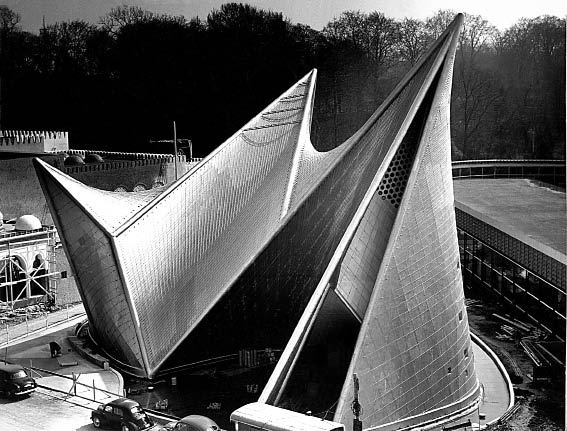When some 700 people throng the auditorium at Earl’s Court to hear a debate about whether eco houses are ugly, then a frustrated tree-hugger like myself may feel that we are halfway to heaven, not that I plan to share my Elysium with Germaine Greer in ranting mode if I can avoid it.
When some 700 people throng the auditorium at Earl’s Court to hear a debate about whether eco houses are ugly, then a frustrated tree-hugger like myself may feel that we are halfway to heaven, not that I plan to share my Elysium with Germaine Greer in ranting mode if I can avoid it. Her views on domestic architecture, like those of most radical intellectuals, seem to be strictly bourgeois and conventional, so that, despite her passion for this particular campaign, she is becoming the Jeremy Clarkson of architectural criticism.
Greer was opposed in the debate by the architect Bill Dunster, designer of the pioneering housing complex, BedZED, at Hackbridge, Surrey, for the Peabody Trust, and several (but not nearly enough) subsequent projects of lesser size. Dunster and his firm, ZEDfactory, deserve to go all the way to the green heaven, whether or not some people are upset by the shapes and colours of the wind cowls on their buildings. His projects do not just maximise the use of solar energy by the simplest means, they also aim to ease the Clarksons of the world into a lifestyle where the right choices become the canny ones, since by living in a ZED (Zero Fossil Energy Development), life becomes cheaper, healthier and more enjoyable. The ecological footprint of the average Briton is the equivalent of three planets, the measure of how far our consumption of resources and production of waste extends beyond our share of the global surface. Even a BedZED resident owning a Porsche (an Eco-slob, in Dunster’s terminology) can cut down to two planets without taking thought about it. A more dedicated bicycling Eco-saint can actually live within their personal allowance of the global commons, and this matters because, if we can’t do this, someone else in the world suffers for our excess, as well as the whole system spiralling out of control.
The Franny Armstrong film, The Age of Stupid, released in late March, ratchets up the urgency of Al Gore’s An Inconvenient Truth. The buildings depicted are mostly the remains of those in New Orleans after Hurricane Katrina, but it underscores the extreme urgency of action on all fronts. At present, building corresponding to the ZED standard being half-achieved, largely owing to the tightening of the building regulations in Britain but, in 2050, at least 80 per cent of our existing building stock (the part that is not under water owing to rising sea levels) will still be with us, and, unless it undergoes energy-saving modification very soon, it will have helped us travel on the road to hell along which Mr Clarkson is still so merrily speeding.
The Greer–Dunster debate, which took place at the fifth annual Ecobuild exhibition earlier this month, served its purpose in attracting attention, demonstrating that the subject of sustainable, green or eco-building is still a difficult one to present to the public with the seriousness needed. The lack of an agreed name is only the beginning of the problem. Government policy, especially as directed towards owners of single buildings wishing to invest in energy-saving improvements, has been worthy of The Age of Stupid, and only by allowing much more eye-catching disasters to unfold over the same period has the government managed to deflect deserved criticism for stunting the growth of new green industries in micro-generation and insulation. While the more liberal sections of the press have adopted green causes with gusto, there is a widespread confusion and scepticism that seems causally linked to Greer’s willingness to apply her formidable intelligence to obscuring the real issues with prejudices about the shape of windows.
Criticising the design of the bailer while the boat is sinking is displacement activity. On the other hand, what appeals to the eye is more likely to encourage consensus and engagement in solving these problems. The never-resolved split between how architects like buildings to look, and what the public prefers, does risk increasing the drag factor in accelerating the kind of changes we need in the built environment. Both sides tend to cherish their prejudices, partly because the opportunities for mediation seem so few.
The answer ought to lie symbolically somewhere between the two major architecture exhibitions currently in London: Andrea Palladio at the Royal Academy (until 13 April) and Le Corbusier at the Barbican (until 24 May). Enthusiasts for Le Corbusier believe that you cannot design today in the manner of Palladio, although the many manners of Le Corbusier do not suffer from the same prohibition. Both modes lend themselves to energy saving design and the spirit of Palladio is well adapted to green design, as some portions of Poundbury already demonstrate (see www.working-group.co.uk for examples). Both architects have been among the most influential in history, although their individual creativity has often been reduced to a formula and they have acquired a bad name in some quarters. Both were responsive to sites and contexts, while the publication of their works (and both were masters of the self-promoting book) cannot really give the sense of each building’s relationship with its site. If eco-architecture isn’t about a sense of place, then something must be wrong, so there is a deeper message to be learnt about the relationship between the look of the thing and its rightness there and then. It’s no guarantee of good architecture — but what is?






Comments